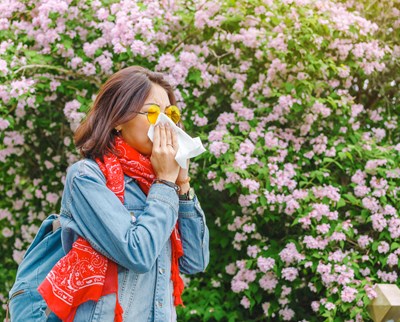
Have you been sneezing a lot lately? Are your eyes extra watery? Do you feel a constant tickle in your throat? Even if you don’t typically deal with allergies, you may have been experiencing symptoms, as we are amid some of the worst allergy seasons to date. And if you feel like your allergy symptoms are getting worse each year, it’s may not be just your imagination.
Pollen Allergies
One of the most common allergens in the world is pollen. Of the more than 67 million Americans suffering from allergies, more than 80% deal with a pollen allergy. Due to the warming climate and rising carbon dioxide levels in the air, plants are tricked into thinking it’s time to bloom extra early, therefore making their growing season longer than usual.
Pollen is made up of male gametes from seed plants and it is easily transferable. The seeds can catch on to your clothes, you’ll find it on your pets, all over your vehicles, and even if you don’t see it—it’s everywhere.

Combating Allergy Symptoms
Combating allergy symptoms due to pollen may look different from person to person. However, below are three general tips on reducing potential exposure to pollen throughout the allergy season.
Regularly Cleaning
Control the levels of pollen allergens throughout every surface or fabric in your home. Regularly cleaning, including activities such as vacuuming or washing sheets, will help to reduce any build-up of allergens in your home throughout the season.
Tracking Pollen Counts
Pollen counts for the outdoor air are available each allergy season. Learning when counts are high and other methods to limiting exposure will help in your combat against pollen allergy symptoms. Information about pollen counts, factors that affect it, and other methods of preventing pollen allergy symptoms are available here.
Using an Air Purifier
Another step you can take to reduce exposure to pollen, which can cause allergy symptoms, outside of taking medicine or limiting your time outdoors, is to use an air purifier in your home. While allergens typically stem from outdoor sources, they can very easily invade your home, leaving you with no escape. An air purifier can help remove unwanted pollen from your home and provide a long-term solution to combatting indoor allergens.
How Air Purifiers Help
In-home air purifiers help to eliminate odors and pollutants, so that the air you’re breathing inside your home is cleaner. Breathing air that’s of poor quality may have negative effects on your health and these small particles can trigger allergy symptoms.

Changes in the ragweed pollen season between 1995 and 2015 | Environmental Protection Agency
Pollen is one of the particles that an air purifier can reduce from the air inside your home. The average size of pollen is about 25 microns; however, it can be as large as 200 microns and as small as 2.5 microns. Most air purifiers can capture at least the average size of a pollen particle; however, many cannot detect the in-home air quality.
Why TruSens for Pollen Allergens?
TruSens Air Purifiers allow you to take control of the air you breathe and help minimize allergens in your indoor space during the pesky allergy seasons. All TruSens Air Purifiers are designed to capture airborne pollutants as small as 0.3 microns. This allows them to capture dust, pollen, mold spores, and other airborne pollutants. TruSens also offers a Specialty Allergy & Flu Filter that captures 99% of airborne allergens.


